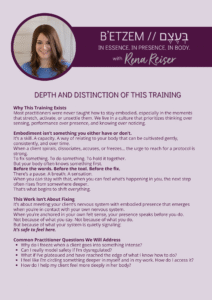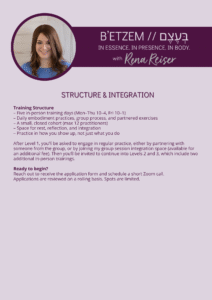Sleepiness, silence, and strange words: what they mean in somatic practice
Someone sent me a few thoughtful questions which I’m sharing below with my answers. I loved the depth behind what she was asking, and I think many of you may have wondered similar things especially if you’ve been practicing embodiment work, Focusing, or any somatic-based modality with clients (or yourself).
Here’s what she asked and how I responded.
What does it mean when a client gets sleepy during a somatic or embodiment practice?
A client gets sleepy during a somatic or embodiment practice for one of two reasons. The parasympathetic nervous system is kicking in, so either it is coming from the client coming to a place of safety, and if they are exhausted, which can happen when a client has undergone lots of ongoing dysregulation and activation, then the body is finally able to feel its exhaustion when it feels more regulated.
Alternatively, the other branch of the parasympathetic nervous system is shutdown, and sometimes it doesn’t feel safe to go into the body, and so the body then activates shutdown as a protective mechanism.
How can we tell if the sleepiness is coming from deep relaxation or from a shutdown response?
It really comes down to connection. Is the client feeling connected or disconnected? Regulation and the healthy parasympathetic nervous response will always lead to connection: connection with self, connection with Hashem, connection with others. If it’s coming from a shutdown response, it’ll be a complete disconnection.
What can a practitioner do to gently guide a client back into presence?
Well, actually, I tend to do very little. My goal is not to necessarily bring them back. The body is doing it for a reason, and we don’t want to demonize the body’s natural healthy responses to perceived danger.
What I will do in this situation is let them know that I’m right there with them. That sends a cue of safety to their body that they’re not alone. So even if their body needs to be in a defensive state, they don’t have to be there alone.
What should someone do if no words or images arise during a focusing or embodiment practice?
It’s possible that it’s a matter of time. Sometimes it needs more time to sit with it, needs more questions to help it open up and develop into something. A felt sense isn’t something that’s there, and we just all of a sudden know that it’s there. It’s something that needs to be developed, and so it could definitely take longer.
Alternatively, sometimes nothing is a felt sense. No response is also a response.
What if a seemingly random word like “teeth” comes up?
If a seemingly random word like teeth pops into awareness during an exercise, we take that word back and check with the felt sense if it’s meaningful: Does this word match?
If it does, your body will let you know. If it doesn’t, your body will also let you know. And that’s how you can tell if it’s meaningful or if it’s just noise.
Want to go deeper into this work?
These kinds of questions and the answers that unfold are at the heart of what my participants experience in my facilitator training. If this speaks to you, and you want to bring more embodiment and presence into your practice as a therapist, coach, or healer, you’re welcome to learn more about the training.
The next facilitator training begins in two weeks on July 28.
To join, you’ll need to fill out an application and have a short call with me so we can make sure it’s the right fit.
Early bird pricing ends today.
More details are in the flyers below.



